Mobile Internet promotes the development of intelligent devices, from wearable devices to smart homes. In 2012, smart TVs entered the public view and quickly spread among every family within a few years, and the penetration rate gradually increased. As an important part of the living room economy, the market competition for smart TVs has continued, and traditional TV makers and Internet companies are difficult to distinguish. This year is a year of breakthrough development in the smart TV industry. Not only has sales volume increased rapidly, but also product updates have accelerated. The diversified needs of users for smart TVs have also gradually emerged, and have become the starting point for TV manufacturers.
The team of analysts at the Speed ​​Way Research Institute analyzed and discussed the status quo and future trends of the smart TV industry based on relevant data from the domestic smart TV market and user survey sampling.
Smart TV sales growth
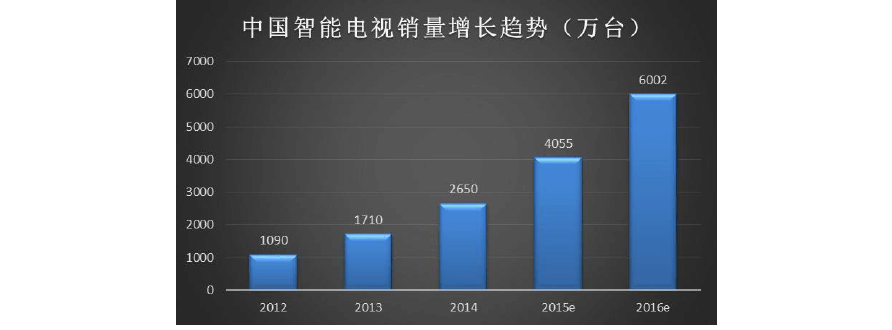
The smart TV market in China is developing rapidly. From a sales perspective, only 10.9 million units of smart TV shipments were shipped in 2012. Last year, sales volume has reached 26.5 million units, which has almost doubled 2.5 times, and the growth rate has continued to accelerate. This year sales will exceed 40 million units and 2016 will exceed 60 million units. Television is one of the most commonly used devices in the home. With the advent of intelligentization, the speed of change is no less than that of mobile phones, and even worse than that. With the rapid adoption of smart TVs, it seems as if the living room economy is beginning to be revealed.
Smart TV penetration reaches 84.5%
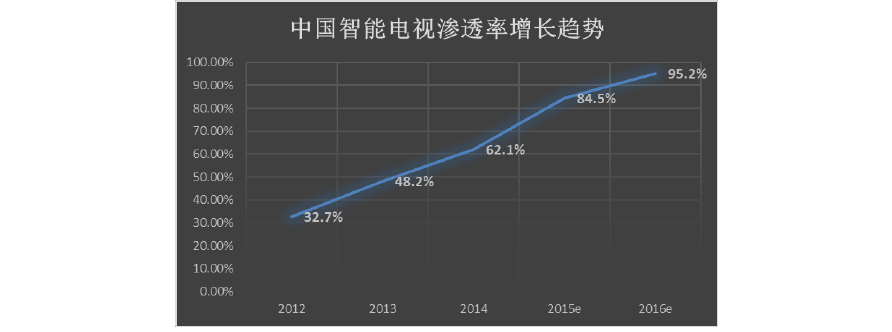
According to the growth rate trend of the penetration rate of smart TVs, the penetration rate of smart TVs was only 32.7% in 2012, and the penetration rate reached 48.2% at the end of 2013, indicating a steady and rapid growth trend. Last year, the penetration of smart TVs. It has reached 62.1% and it is expected that the penetration rate of domestic smart TV will reach 84.5% this year, and the penetration rate in 2016 will exceed 95%. It is expected that by the end of 2016, smart TVs will reach a basic level of popularity in China, and traditional television innovation will be completed initially, and the smart TV industry will enter a period of stable growth, and the market will begin to slow down.
Domestic smart TV brands focus on music as the leader

This year's smart TV industry has developed rapidly and the competition is fierce. The gap between the mainstream smart TV brands has gradually narrowed, and the attention of mainstream smart TV brands is evenly distributed. Among them, LeTV brand's attention is slightly higher than that of other TV brands by 14.2%. First, this is the first time in the smart TV industry that Internet TV brands have surpassed traditional TV brands for the first time. This shows that the smart TV industry is in the Internet-related industry and is essentially different from the traditional TV industry. If the traditional TV industry wants to maintain its leading position, In terms of status, we must adjust our strategy and accelerate innovation.
Smart TVs account for over 50% of rural sales
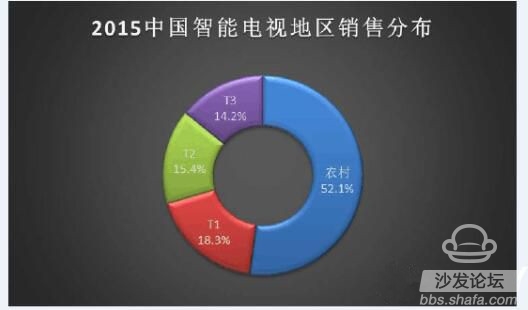
After entering the stage of rapid development, smart TVs began to be popularized in the developed cities of the T1 level. Then the market gradually spread to T2 and T3 cities and simultaneously shifted to rural areas. After the smart TVs in the urban areas were basically completed, the rural market began to show up. Its huge purchasing power and market space, this year's distribution of smart TVs in rural areas accounted for more than 50%, representing the smart TV is completing the final level of the market's popularity, while the rural economy and the rapid development of the conditions, rural and urban areas and the outside world The connection has gradually become closer. With the increase of farmers' income, the countryside will surely become an important market in the future.
90% of smart TV system Android

In the current operating system of Chinese smart TVs, the Android system (including smart TV systems) already accounts for 90% of the total, and it has become the most user-friendly and user-friendly system type. In addition, the market share of the Android system has been gradually increasing. Before the mainstream smart TV companies or technology companies have developed more advanced systems, the Android system will become the largest operating system in the smart TV market. Do not rule out the possibility of new systems.
Smart TVs are mainly distributed in three families
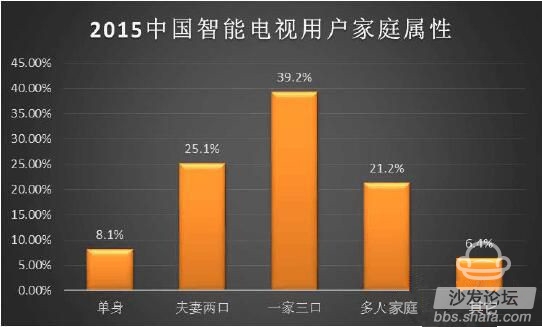
Through the family attributes of smart TV users, it can be seen that smart TVs are mainly distributed among a family of three, accounting for nearly 40% of the total, and 25.1% of smart TV users are a family of two. Such people are mainly relative to each other. The younger 80s were mainly crowded, and some elderly families, with multi-person households accounting for 21.2%. Smart TV users accounted for 8.1% of singles, and the single dog's interest target began to shift to the big screen. It shows that smart TVs have become the same as smart phones in general and have become a common type of device for people. With the gradual reduction of the cost of smart TVs and people’s awareness of smart devices, smart TVs have become detached from the “big household appliances†in the past. The concept began as an indispensable entertainment tool in our lives.
Image quality is the user's top priority
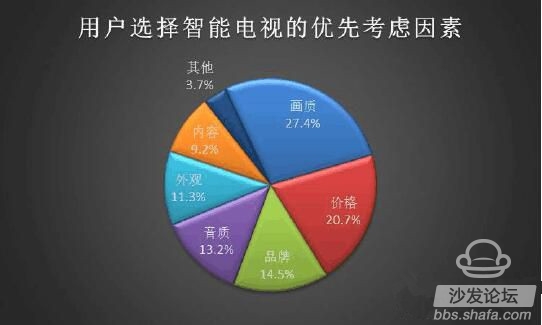
According to the survey on the user's preference for selecting smart TVs, 27.4% of users have the highest priority on the quality of the TV, followed by the price, accounting for 20.7%, followed by the brand, sound quality, appearance, and content. When television enters the era of intelligence, users have different requirements for the purchase of television. They no longer consider price as the first consideration factor, but pay more attention to product quality. They are the criteria for increasing consumer spending and improving people’s living standards. There is little difference in the proportion of other considerations, and video content is a must-win area for Internet TV. Currently, it accounts for only 9.2% of the factors considered, and the proportion of the content in the future will gradually increase.
Living room economy will reach trillion levels

The living room economy is the realization of the value of the services provided by smart homes. Through smart homes, the quality of life at home is enhanced, and smart TVs will undoubtedly become the center of the living room economy. This is the future growth point of smart TVs. Smart TV not only undertakes the carrier for family members to participate in entertainment activities, but also becomes the most frequently contacted smart device in the family. It gradually evolves into an important entrance to the living room Internet and becomes the center of connecting other smart homes. The 2015 Chinese living room The overall economic valuation is 268.65 billion yuan. It is estimated that after the next five years, the overall valuation of the living room economy will exceed one trillion yuan, and a trillion-level market is coming.
Hou Changhai, an analyst at Speed ​​Research Institute, believes that 2015 is the first year for the smart TV industry to enter the development stage of blowout. There will be a huge increase in value in the future. There are two main reasons: First, after the intelligentization of the TV itself, , Its diversified entertainment functions began to be excavated. Excellent content and entertainment methods such as games began to attract users to gradually return to the living room, and through the calculation of big data, constantly tap the needs of users, provide personalized services for users, and give full play to them. The living room scene TV brings entertainment features that increase user stickiness. Second, smart TVs will become the center of the living room ecology, give full play to the value of the screen, and become the carrier of other intelligent services. What's more, under the conditions of diversified mature profit models in the future economic development of the living room, smart TV will undoubtedly become an entrance.
The team of analysts at the Speed ​​Way Research Institute analyzed and discussed the status quo and future trends of the smart TV industry based on relevant data from the domestic smart TV market and user survey sampling.
Smart TV sales growth

The smart TV market in China is developing rapidly. From a sales perspective, only 10.9 million units of smart TV shipments were shipped in 2012. Last year, sales volume has reached 26.5 million units, which has almost doubled 2.5 times, and the growth rate has continued to accelerate. This year sales will exceed 40 million units and 2016 will exceed 60 million units. Television is one of the most commonly used devices in the home. With the advent of intelligentization, the speed of change is no less than that of mobile phones, and even worse than that. With the rapid adoption of smart TVs, it seems as if the living room economy is beginning to be revealed.
Smart TV penetration reaches 84.5%

According to the growth rate trend of the penetration rate of smart TVs, the penetration rate of smart TVs was only 32.7% in 2012, and the penetration rate reached 48.2% at the end of 2013, indicating a steady and rapid growth trend. Last year, the penetration of smart TVs. It has reached 62.1% and it is expected that the penetration rate of domestic smart TV will reach 84.5% this year, and the penetration rate in 2016 will exceed 95%. It is expected that by the end of 2016, smart TVs will reach a basic level of popularity in China, and traditional television innovation will be completed initially, and the smart TV industry will enter a period of stable growth, and the market will begin to slow down.
Domestic smart TV brands focus on music as the leader

This year's smart TV industry has developed rapidly and the competition is fierce. The gap between the mainstream smart TV brands has gradually narrowed, and the attention of mainstream smart TV brands is evenly distributed. Among them, LeTV brand's attention is slightly higher than that of other TV brands by 14.2%. First, this is the first time in the smart TV industry that Internet TV brands have surpassed traditional TV brands for the first time. This shows that the smart TV industry is in the Internet-related industry and is essentially different from the traditional TV industry. If the traditional TV industry wants to maintain its leading position, In terms of status, we must adjust our strategy and accelerate innovation.
Smart TVs account for over 50% of rural sales

After entering the stage of rapid development, smart TVs began to be popularized in the developed cities of the T1 level. Then the market gradually spread to T2 and T3 cities and simultaneously shifted to rural areas. After the smart TVs in the urban areas were basically completed, the rural market began to show up. Its huge purchasing power and market space, this year's distribution of smart TVs in rural areas accounted for more than 50%, representing the smart TV is completing the final level of the market's popularity, while the rural economy and the rapid development of the conditions, rural and urban areas and the outside world The connection has gradually become closer. With the increase of farmers' income, the countryside will surely become an important market in the future.
90% of smart TV system Android

In the current operating system of Chinese smart TVs, the Android system (including smart TV systems) already accounts for 90% of the total, and it has become the most user-friendly and user-friendly system type. In addition, the market share of the Android system has been gradually increasing. Before the mainstream smart TV companies or technology companies have developed more advanced systems, the Android system will become the largest operating system in the smart TV market. Do not rule out the possibility of new systems.
Smart TVs are mainly distributed in three families

Through the family attributes of smart TV users, it can be seen that smart TVs are mainly distributed among a family of three, accounting for nearly 40% of the total, and 25.1% of smart TV users are a family of two. Such people are mainly relative to each other. The younger 80s were mainly crowded, and some elderly families, with multi-person households accounting for 21.2%. Smart TV users accounted for 8.1% of singles, and the single dog's interest target began to shift to the big screen. It shows that smart TVs have become the same as smart phones in general and have become a common type of device for people. With the gradual reduction of the cost of smart TVs and people’s awareness of smart devices, smart TVs have become detached from the “big household appliances†in the past. The concept began as an indispensable entertainment tool in our lives.
Image quality is the user's top priority

According to the survey on the user's preference for selecting smart TVs, 27.4% of users have the highest priority on the quality of the TV, followed by the price, accounting for 20.7%, followed by the brand, sound quality, appearance, and content. When television enters the era of intelligence, users have different requirements for the purchase of television. They no longer consider price as the first consideration factor, but pay more attention to product quality. They are the criteria for increasing consumer spending and improving people’s living standards. There is little difference in the proportion of other considerations, and video content is a must-win area for Internet TV. Currently, it accounts for only 9.2% of the factors considered, and the proportion of the content in the future will gradually increase.
Living room economy will reach trillion levels

The living room economy is the realization of the value of the services provided by smart homes. Through smart homes, the quality of life at home is enhanced, and smart TVs will undoubtedly become the center of the living room economy. This is the future growth point of smart TVs. Smart TV not only undertakes the carrier for family members to participate in entertainment activities, but also becomes the most frequently contacted smart device in the family. It gradually evolves into an important entrance to the living room Internet and becomes the center of connecting other smart homes. The 2015 Chinese living room The overall economic valuation is 268.65 billion yuan. It is estimated that after the next five years, the overall valuation of the living room economy will exceed one trillion yuan, and a trillion-level market is coming.
Hou Changhai, an analyst at Speed ​​Research Institute, believes that 2015 is the first year for the smart TV industry to enter the development stage of blowout. There will be a huge increase in value in the future. There are two main reasons: First, after the intelligentization of the TV itself, , Its diversified entertainment functions began to be excavated. Excellent content and entertainment methods such as games began to attract users to gradually return to the living room, and through the calculation of big data, constantly tap the needs of users, provide personalized services for users, and give full play to them. The living room scene TV brings entertainment features that increase user stickiness. Second, smart TVs will become the center of the living room ecology, give full play to the value of the screen, and become the carrier of other intelligent services. What's more, under the conditions of diversified mature profit models in the future economic development of the living room, smart TV will undoubtedly become an entrance.